In 2016, I found the following article by K.S. Bains very interesting: it talks about the achievements of Guru Arjan that are often overlooked. Following this article is youtube playlist of Guru Arjan Dev's shabads. After that are some notes I took in 2020 before a kirtan dedicated to the martyrdom of Guru Arjan Dev. Also towards the end of this note is a playlist of shabads of Guru Arjan
K.S. Bains on the first Sikh martyr, who changed the course of Sikhism
The martyrdom of Guru Arjan Dev changed the path of progress of the Sikh religion. While paying homage to him on his martyrdom day, we generally highlight the compilation of the Adi Granth and the construction of the Golden Temple as his main contributions. No doubt, these are two very concrete statements of crystallisation of the Sikh religion, the former becoming the seat and the latter the holy book, the two bases of any religion. However, we generally overlook his other very significant contributions.
Hari Ram Gupta, in his book, History of Sikh, observes:
"Guru Arjan, Fifth in succession, was the first Guru born as a Sikh. He proved himself an original thinker, illustrious poet, practical philosopher, great organiser, eminent statesman, shining sage, saint and seer, composer of music, scholar, founder of tanks and towns, embodiment of love, humility and service, and the first martyr to faith. He was a dutiful son, conciliatory brother, loving husband, inspiring father, beloved master and devoted servant of God. He possessed a tender heart but resolute will. He was forgiving but fearless, firm in his faith like a rock, but never a fanatic. He completely changed the external aspect of Sikh religion."
There are enough occurrences in his life to write about each of the qualities mentioned. That will require volumes. I will dwell only on two aspects, namely, putting finances on a sound footing and encouraging trade and commerce.
The fourth Guru, Guru Ramdas, had started the institution of angtias to accept offerings from the Sikhs from their allotted areas and pass on the same to the guru. Another similar category was asand, a slightly higher position than that of a sangtia. Taking a cue from the Muslim system of zakat, he called upon his followers to contribute daswandh, or 10 per cent of their income, to the Guru. Sangtias/masands were asked to encourage the Sikhs to contribute and make collections on behalf of the Guru. To strengthen the system and make it workable on a long-term basis, he laid down that the sangtias/masands could keep tith, or 33 per cent of the offerings with them as their service fees and pass on the remaining two-thirds to the Guru. This system worked well and helped the Guru in taking various measures in the expansion of Sikhism. We all know about his great work in constructing gurdwaras, townships and the like. With the regular flow of finances, the entire system of collecting funds was streamlined, thus helping the Guru with his plans.
He encouraged his followers to take to trade and commerce. There were three reasons behind this. First, most of the followers at that time were subsistence farmers and did not enjoy proper social status. Trading increased the income of the farmers. Alongside, it encouraged the coming up of a stronger agricultural class who started enjoying higher social status and got some surplus to spend and live well.
Secondly, another section of society, the traders, became his followers. His followers not only traded in the adjoining areas but went right up to Kabul and beyond for trading in dry fruits and more importantly, horses. Initially, they brought horses for the purpose of trading and earning a profit. However, gradually, they started keeping the animals for their own use, too. Owning a horse was a symbol of great social status and superiority.
Gupta observes that this made them fearless and free from caste prejudices. There is, however, another aspect that is of greater significance. Slowly, with the owning of horses Sikhs started acquiring proficiency in riding and tent-pegging. They also started going for shikar and became adept in the use of various arms that are normally a part of cavalry.
Thirdly, these owners of horses and their attendants became ready raw material for forming an army, should such a need arise. It did happen in the time of the sixth Guru. Now, the question arises whether such a development was something which happened on its own or the Guru could foresee the shape of things to come. He was aware of the fact that as the religion expanded and the organisation became well-ordered and well-knit the finances and social status of the followers improved and they started living in style, they were bound to come into conflict with the state. The author of Dabistan observes, "Some of the Sikh Gurus took to agriculture and others to trading. They became good horsemen, created their own identity and acquired the position of a separate state within the Moghul State."
A few days before his martyrdom, the Guru sent to his 11-year-old son a bel fruit with five copper pieces as a token of nominating him as the next Guru. He also sent an injunction through the Sikh who carried the bel: Let him sit fully armed on his throne and maintain his army to the best of his ability. The rest, as they say, is history.
Guru Arjan Dev gave the Sikhs their church and their holy book. With these, the Sikh became a separate identity as distinct from Hindus and Muslims. The Faith acquired a strong spiritual, doctrinal and organisational base and became a potential force in encouraging a social revolution in Punjab. Khushwant Singh has observed Arjan Devji "became the seed of the Sikh church as well as Punjabi nation."
Shabads of Guru Arjan:
Other Notes:
This week marks the Martyrdom Day (Shaheedi Diwas) of Guru Arjan Dev. In preparation for a talk about the martyrdom this week, I am compiling this research:
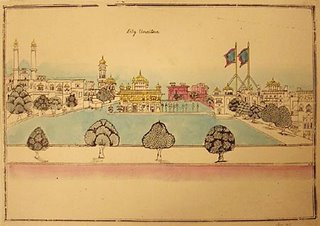
During Guru Arjan's time, a community formed in the city of Amritsar. This community believed believed in the oneness of all and disregarded the superstitions propagated by the established religions.
Guru Arjan orchestrated the compilation of a scripture call the Adi Granth, which contained poetry of oneness. In addition to poetry from the five Gurus, it contains the poetry of Hindu and Muslim saints who also believed in oneness. There is evidence from a recent PhD thesis that kirtan (the singing of the songs of oneness) was started around Amritsar even before the construction of a temple. Then a glorious temple called Darbar Sahib was built with the help of volunteers in Amritsar. The foundation stone was laid by the reputed Muslim Sufi Saint, Mian Mir. Darbar Sahib had doors on all sides, indicating that these were open to all castes and communities.
PLOT AGAINST GURU SAHIB
In "Tuzuk-i-Jahagiri" ("Memoirs of Jahangeer"), Jahangeer wrote:
"In Gobindwal, which is on the river Biyah (Beas), there was a Hindu named Arjun, in the garments of sainthood and sanctity, so much so that he had captured many of the simple-hearted of the Hindus, and even of the ignorant and foolish followers of Islam, by his ways and manners, and they had loudly sounded the drum of his holiness. They called him Guru, and from all sides stupid people crowded to worship and manifest complete faith in him. For three or four generations (of spiritual successors) they had kept this shop warm. Many times it occurred to me to put a stop to this vain affair or to bring him into the assembly of the people of Islam.
At last when Khusro passed along this road this insignificant fellow proposed to wait upon him. Khusro happened to halt at the place where he was, and he came out and did homage to him. He behaved to Khusro in certain special ways, and made on his forehead a finger-mark in saffron, which the Indians (Hindus) call qashqa (Tilak) and is considered propitious. When this came to my ears and I clearly understood his folly, I ordered them to produce him and handed over his houses, dwelling-places, and children to Murtaza Khan, and having confiscated his property commanded that he should be put to death."
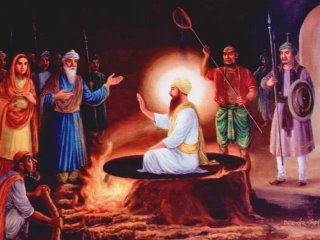
Guru Arjan Dev Jee sowed the seed of martyrdom which flourished after him and became the heritage of the Sikh People. Guru Sahib physically manifested and lived the Divine message of Gurbaani of conquering death and suffering, remaining fearless in defending the Truth, and showing the extremes one can take in remaining steadfast in the love of Waheguru and Guru Nanak Jee's Sikhi. Guru Arjan Dev Jee said, lived, and showed that he can accept Shaheedi (martyrdom) but he cannot accept insult. The way a leader or prophet lives becomes the character of the followers. Guru Sahib showed that a Sikh should live in dignity and die with honour, and that a Sikh should never tolerate insult or oppression.
What do we learn?
Fearlessness
Boundless Optimism
Fighting Opression
Traditionally, Sikhs commemorate the martyrdom by the free distribution of sweetened and chilled drinks to all. Instead of remembering this event through mourning, the Guru taught the Sikhs to accept Gods will as sweet. Therefore, Sikhs changed negativity to positivity by turning an attack upon them into a chance to serve others. Sikhs honour the Guru’s burning by cooling everyone else. This is Chardi-Kala.
From Shabad to Shahadat: Why is it relevant today?
Department of Guru Nanak Sikh Studies Panjab University (PU), Chandigarh organized a Special lecture commemorating the great Martyrdom day of Sri Guru Arjan Dev Ji. The lecture was delivered by Professor Jaspal Kaur Kaang Chairperson of the Department to her research Scholars on the topic ‘Guru Arjan: Shabad to Shahadat Tak’.
The Real Story of One of the Greatest Martyrdoms:
Amritsar becomes the center of the philosophy of oneness
Amritsar becomes the center of the philosophy of oneness

During Guru Arjan's time, a community formed in the city of Amritsar. This community believed believed in the oneness of all and disregarded the superstitions propagated by the established religions.
More and more people of different religions and castes were embracing the path of oneness and becoming Sikhs (meaning disciples). The higher caste Hindus did not like this. The Muslim clergy also did not like this and saw Guru Arjan Dev Jee as a threat to the propagation of Islam. As a consequence of this they made plans against Guru Sahib.
There is also a personal story that is relevant here.
EMPEROR JAHANGEER & GROWING ENEMIES OF THE SIKHS
After the death of Mughal Emperor Akbar in 1605, his son Jahangir sat on the throne. Unlike his liberal, tolerant and open-minded father, Jahangeer’s policies and views were to fanatical and radical in pursuit of spreading Islam. The enemies of Guru Sahib took advantage of this highly charged atmosphere.
Prithi Chand: To begin with, it was Guru Sahib's elder brother, who devoted his whole life to harm the Guru in every possible way.
Chandu Shah: He was the Brahman advisor and officer of Jahangeer. He held animosity over his daughter's non-alliance with the Guru Sahib's son, which is considered the main fuel for his vendetta.
Naqshbandi, Sheikh Ahmad Sirhindi and Sheikh Fareed Bukhari, (Murtaza Khan), Governor of Panjab: Zealous Muslims who were jealous of the growing popularity of Sikhi and considered Guru Arjan Dev jee and the Sikhs a threat to the growth of Islam.
Mahesh Daas Bhatt (known as Birbal): An anti-Sikh Hindu Brahmin, who considered Guru Arjan Dev jee a threat to Brahmanism.

Prithi Chand: To begin with, it was Guru Sahib's elder brother, who devoted his whole life to harm the Guru in every possible way.
Chandu Shah: He was the Brahman advisor and officer of Jahangeer. He held animosity over his daughter's non-alliance with the Guru Sahib's son, which is considered the main fuel for his vendetta.
Naqshbandi, Sheikh Ahmad Sirhindi and Sheikh Fareed Bukhari, (Murtaza Khan), Governor of Panjab: Zealous Muslims who were jealous of the growing popularity of Sikhi and considered Guru Arjan Dev jee and the Sikhs a threat to the growth of Islam.
Mahesh Daas Bhatt (known as Birbal): An anti-Sikh Hindu Brahmin, who considered Guru Arjan Dev jee a threat to Brahmanism.

PLOT AGAINST GURU SAHIB
These men with jealousies in their hearts, concocted the real story of Guru Sahib sheltering the rebellious Khusro, Jahangeer's son, who had fled a battle with his father and was a fugitive, to rouse the rage of Emperor Jahangeer which added fuel to the blazing fire. Along with these circumstances Guru Sahib's increasing influence on large numbers of Hindus and Muslims to adopt Gurmat, created a stir in the minds of the Brahmin Pandits (Hindu priests) and the Qazis (Muslim priests). The compilation of Sri Aad Granth jee (the early version of Sri Guru Granth Sahib Jee) was considered a serious blow to the monopolies and social oppression maintained by so-called men of religion. Through all these circumstances Guru Arjan Sahib Jee fell a victim to the bigotry and inhumanity of Jahangeer.
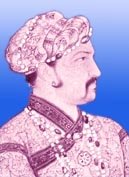

ARREST OF GURU SAHIB
In "Tuzuk-i-Jahagiri" ("Memoirs of Jahangeer"), Jahangeer wrote:
"In Gobindwal, which is on the river Biyah (Beas), there was a Hindu named Arjun, in the garments of sainthood and sanctity, so much so that he had captured many of the simple-hearted of the Hindus, and even of the ignorant and foolish followers of Islam, by his ways and manners, and they had loudly sounded the drum of his holiness. They called him Guru, and from all sides stupid people crowded to worship and manifest complete faith in him. For three or four generations (of spiritual successors) they had kept this shop warm. Many times it occurred to me to put a stop to this vain affair or to bring him into the assembly of the people of Islam.
At last when Khusro passed along this road this insignificant fellow proposed to wait upon him. Khusro happened to halt at the place where he was, and he came out and did homage to him. He behaved to Khusro in certain special ways, and made on his forehead a finger-mark in saffron, which the Indians (Hindus) call qashqa (Tilak) and is considered propitious. When this came to my ears and I clearly understood his folly, I ordered them to produce him and handed over his houses, dwelling-places, and children to Murtaza Khan, and having confiscated his property commanded that he should be put to death."

Tortures
Chandu, the officer of Jahangeer, was in charge of torturing Guru Sahib. Guru Sahib told them, "I bear no enemies or ill-will against any one. All happens as God Almighty wills it to happen. I am prepared to accept His Will. You may do what you like".
Day 1 of Torture: Chandu began to torture the Guru. On the first day, Guru Jee was not given anything to eat or drink. He was kept awake and not allowed to sleep at night. During the day his body was left in the full exposure of the burning heat of the sun. Guru Sahib bore all this calmly. He remained immersed in Simran and repeated from his lips, "WaaheGuroo, WaaheGuroo, WaaheGuroo..." and sang Shabads from Gurbaani.
Day 2 of Torture: On the following day, Chandu made the Guru sit in a large copper vessel. He filled the vessel with water. He ordered his men to light a fire under the copper vessel. The water began to get hot. After a time, the water began to boil. It scaled Guru Sahib's body. But Guru Jee sat calmly and quietly. He showed no feeling of pain, nor did he cry out or even sigh. He felt no anger against those who were torturing him. He remained absorbed in the sweet remembrance of Waheguru and repeated, "All is happening, O Waheguru, according to Thy Will. Thy Will is ever sweet to me." The boiling water made the Guru's flesh soft and left blisters all over the body.
Day 3 of Torture: On the third day, Chandu ordered his men, "Make some sand red hot in iron pans. Seat the Guru in burning water. Then pour the red hot sand over his head and body". The water boiled Guru Sahib's flesh from below. The burning red-hot sand burned Guru Jee's head and body from above. The persons engaged in torturing him were wet with sweat. They felt most uncomfortable because of the heat. It was the hottest summer month. But Guru Sahib kept calm and quiet. Again, Guru Jee felt no pain, nor did he cry out, sigh or feel anger. He kept thinking of Waheguru and doing Simran. Guru Jee repeated:
Baba Mian Meer Jee (a Muslim Sufi Saint and friend of Guru Sahib) tried to intercede on behalf of Guru Sahib but Guru Jee forbid him to interfere in the "Will of the Almighty". Guru Sahib said, "All is happening in accordance with Waheguru's Will. Men who stand for Truth have often to suffer. Their sufferings give strength to the cause of Truth. Go, brother. Pray for me. Pray for the success of my cause. Pray for Victory to Truth."
Day 4 of Torture: On the fourth day, Guru Jee was made to sit on an iron plate. It was heated from below. The iron plate became red hot with the heat. Guru Jee's flesh began to be roasted. Burning red-hot sand was poured on his body. Guru Sahib sat calm and quite, without a cry or sigh, feeling no physical pain. He sat with his mind fixed on Waheguru and physically living the message of Gurbaani and accepting the Will of Waheguru sweetly.
Day 5 of Torture: On the fifth day, Guru Sahib was taken to the bank of the River Raavi bounded in shackles. Guru Sahib's physical body was covered with burns and blisters. Guru jee was pelted with rocks. One rock hit Guru jee on his forehead which led to bleeding. Two drops of blood fell to the ground. Jahangeer had given strict orders that Guru jee should be tortured to death in a such a way that his blood should not fall on the ground in the belief that a holy or great man's blood spilling on the ground leads to further martyrs being born. This tradition was called Nasar law and was upheld by Genghis Khan. To hide the bloodied body of Guru jee, the soldiers threw Guru jee's body in the River Raavi and then concocted a story that Guru jee went to bathe and never came out of the river. This fake story was used to firstly, make the martyrdom into a suicide case and ensure that people do not revolt in response to the barbaric martyrdom of Guru jee.
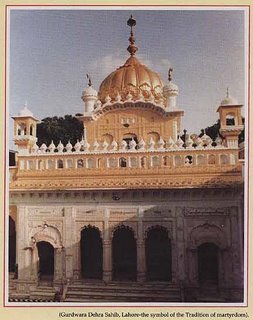
Day 1 of Torture: Chandu began to torture the Guru. On the first day, Guru Jee was not given anything to eat or drink. He was kept awake and not allowed to sleep at night. During the day his body was left in the full exposure of the burning heat of the sun. Guru Sahib bore all this calmly. He remained immersed in Simran and repeated from his lips, "WaaheGuroo, WaaheGuroo, WaaheGuroo..." and sang Shabads from Gurbaani.
Day 2 of Torture: On the following day, Chandu made the Guru sit in a large copper vessel. He filled the vessel with water. He ordered his men to light a fire under the copper vessel. The water began to get hot. After a time, the water began to boil. It scaled Guru Sahib's body. But Guru Jee sat calmly and quietly. He showed no feeling of pain, nor did he cry out or even sigh. He felt no anger against those who were torturing him. He remained absorbed in the sweet remembrance of Waheguru and repeated, "All is happening, O Waheguru, according to Thy Will. Thy Will is ever sweet to me." The boiling water made the Guru's flesh soft and left blisters all over the body.
Day 3 of Torture: On the third day, Chandu ordered his men, "Make some sand red hot in iron pans. Seat the Guru in burning water. Then pour the red hot sand over his head and body". The water boiled Guru Sahib's flesh from below. The burning red-hot sand burned Guru Jee's head and body from above. The persons engaged in torturing him were wet with sweat. They felt most uncomfortable because of the heat. It was the hottest summer month. But Guru Sahib kept calm and quiet. Again, Guru Jee felt no pain, nor did he cry out, sigh or feel anger. He kept thinking of Waheguru and doing Simran. Guru Jee repeated:
ਤੇਰਾ ਕੀਆ ਮੀਠਾ ਲਾਗੈ ॥teraa kee-aa meethaa laagai.
O Waheguru! Your actions seem so sweet to me.ਹਰਿ ਨਾਮੁ ਪਦਾਰਥੁ ਨਾਨਕੁ ਮਾਂਗੈ ॥੨॥੪੨॥੯੩॥har naam padaarath naanak maaNgai. ||2||42||93||
Nanak begs for the treasure of the Naam, the Name of the Lord. ||2||42||93||
Baba Mian Meer Jee (a Muslim Sufi Saint and friend of Guru Sahib) tried to intercede on behalf of Guru Sahib but Guru Jee forbid him to interfere in the "Will of the Almighty". Guru Sahib said, "All is happening in accordance with Waheguru's Will. Men who stand for Truth have often to suffer. Their sufferings give strength to the cause of Truth. Go, brother. Pray for me. Pray for the success of my cause. Pray for Victory to Truth."
Day 4 of Torture: On the fourth day, Guru Jee was made to sit on an iron plate. It was heated from below. The iron plate became red hot with the heat. Guru Jee's flesh began to be roasted. Burning red-hot sand was poured on his body. Guru Sahib sat calm and quite, without a cry or sigh, feeling no physical pain. He sat with his mind fixed on Waheguru and physically living the message of Gurbaani and accepting the Will of Waheguru sweetly.
Day 5 of Torture: On the fifth day, Guru Sahib was taken to the bank of the River Raavi bounded in shackles. Guru Sahib's physical body was covered with burns and blisters. Guru jee was pelted with rocks. One rock hit Guru jee on his forehead which led to bleeding. Two drops of blood fell to the ground. Jahangeer had given strict orders that Guru jee should be tortured to death in a such a way that his blood should not fall on the ground in the belief that a holy or great man's blood spilling on the ground leads to further martyrs being born. This tradition was called Nasar law and was upheld by Genghis Khan. To hide the bloodied body of Guru jee, the soldiers threw Guru jee's body in the River Raavi and then concocted a story that Guru jee went to bathe and never came out of the river. This fake story was used to firstly, make the martyrdom into a suicide case and ensure that people do not revolt in response to the barbaric martyrdom of Guru jee.

Summary
Guru Arjan Dev Jee sowed the seed of martyrdom which flourished after him and became the heritage of the Sikh People. Guru Sahib physically manifested and lived the Divine message of Gurbaani of conquering death and suffering, remaining fearless in defending the Truth, and showing the extremes one can take in remaining steadfast in the love of Waheguru and Guru Nanak Jee's Sikhi. Guru Arjan Dev Jee said, lived, and showed that he can accept Shaheedi (martyrdom) but he cannot accept insult. The way a leader or prophet lives becomes the character of the followers. Guru Sahib showed that a Sikh should live in dignity and die with honour, and that a Sikh should never tolerate insult or oppression.
What do we learn?
Fearlessness
Boundless Optimism
Fighting Opression
Attaining Eternity
Celebrations:
Traditionally, Sikhs commemorate the martyrdom by the free distribution of sweetened and chilled drinks to all. Instead of remembering this event through mourning, the Guru taught the Sikhs to accept Gods will as sweet. Therefore, Sikhs changed negativity to positivity by turning an attack upon them into a chance to serve others. Sikhs honour the Guru’s burning by cooling everyone else. This is Chardi-Kala.
From Shabad to Shahadat: Why is it relevant today?
Department of Guru Nanak Sikh Studies Panjab University (PU), Chandigarh organized a Special lecture commemorating the great Martyrdom day of Sri Guru Arjan Dev Ji. The lecture was delivered by Professor Jaspal Kaur Kaang Chairperson of the Department to her research Scholars on the topic ‘Guru Arjan: Shabad to Shahadat Tak’.
While expressing her views on the various aspects of martyrdom of Guru Arjan Dev Ji, she explained that the sacrifice of his life given by Guru Arjan Dev Ji has established a great example of his extreme tolerance power which he attained from the Shabad Chinton of Gurbani. The power of ‘Shabad Chinton’, transforms the fearful person into a fearless and well-determined personality. Guru Arjan Dev Ji had challenged the inhuman political powers prevailing in his time with his period with his inner, bold and determined will power by not submitting himself before the injustice.
Dr. Kaang emphasized on the various aspects of Guru’s Shahadat. At the end of her lecture, she expressed that today we are facing world crisis due to the extreme intolerance in our behavior while Guru Arjan Dev Ji’s message of Naam Simran, Tolerance, Forgiveness and not to submit before the injustice is very relevant in today’s world to resolve several issues of human life and gives us a deep inspiration to follow the same.

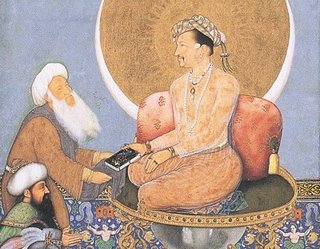
 Singing oneness!
Singing oneness!

0 Comments